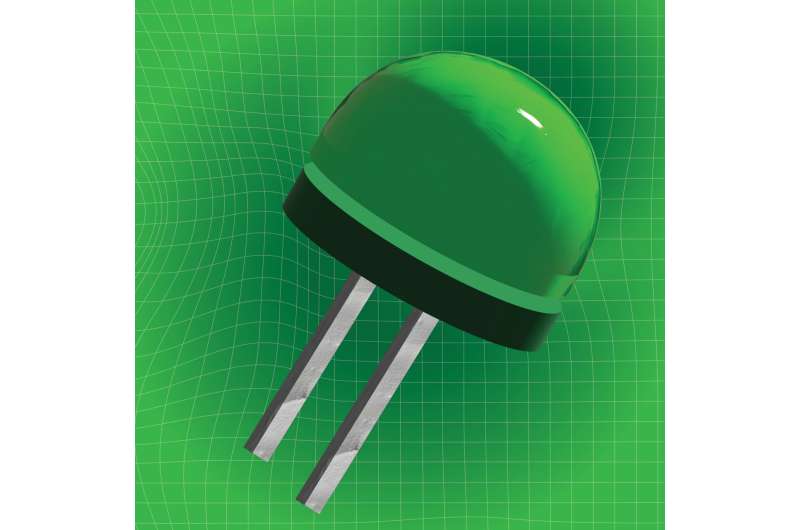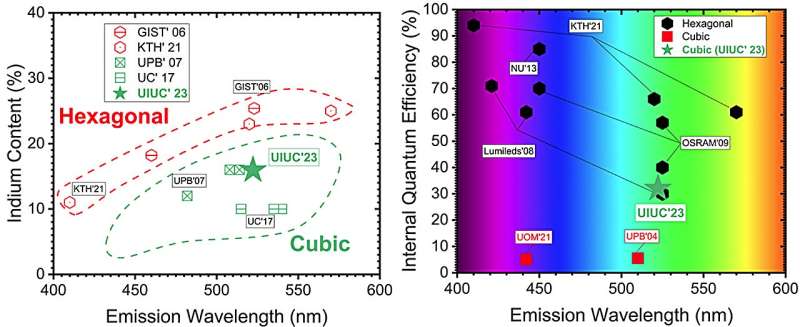This article has been reviewed according to Science X's editorial process and policies. Editors have highlighted the following attributes while ensuring the content's credibility:
fact-checked
peer-reviewed publication
trusted source
proofread
Closing the green gap: A cubic III-nitride active layer with 32% internal quantum efficiency

Color mixing is the process of combining two or more colors: red and green make yellow, blue and red make purple, red and green and blue make white. This process of mixing colors is the basis for the future of solid-state lighting. While currently white light is achieved by phosphor down-conversion, LED color mixing actually has a higher theoretical maximum efficiency, which is needed in order to achieve the 2035 DOE energy efficiency goals.
Despite the potential efficiency of color-mixed LED sources, there exists one significant challenge: green. The "green gap" is described as the lack of suitable green LEDs. Current green LEDs are made from state-of-the-art hexagonal III-nitride but only reach one third of the efficiency goals laid out in the 2035 DOE roadmap.
In a new study, researchers at the University of Illinois Urbana-Champaign have found a potential path to fill the green gap and report a green-emitting cubic III-nitride active layer with 32% internal quantum efficiency (IQE), which is more than 6 times higher efficiency than what is reported in the literature for conventional cubic active layers.
"The ultimate goal is to triple the efficiency of today's white light emitting diodes. And to do that, we need to fill the green gap in the spectrum, which is no easy task. You need innovation. And we show the innovation from the materials side by using cubic nitrides," says electrical and computer engineering professor Can Bayram, who led this work alongside graduate student Jaekwon Lee.
The results of this research were recently published in Applied Physics Letters as an issue cover article.
Today, the most efficient white LEDs use blue light emitting diodes with a rare-earth phosphor coating that converts the blue light into yellow, green and/or red which enables white lighting. This process is called phosphor down-conversion. The phosphors are luminescent materials that can absorb and convert high energy photons (like blue light) into lower energy/longer wavelength light (such as green, yellow and red, respectively).
This process of phosphor down-conversion, however, has limitations. The down-conversion process is inherently inefficient because the high energy photons must lose energy (in the form of heat) to be converted into photons of other energies. Currently, white LEDs used in SSL generate seven times more heat than light output. Further, phosphors are chemically unstable and add significant raw material and packaging costs (by about 20%) to the LED device.
Despite the increase in blue LED efficiency in recent years, SSL using phosphors only has a theoretical maximum luminous efficacy of 255 lumens/watt (lm/W) whereas LED color mixing can achieve a theoretical maximum luminous efficacy of 408 lm/W.
However, many established approaches for green LEDs are plagued with "efficiency droop" at high current densities. Achieving high-efficiency green emission has been difficult with traditional hexagonal III-nitride even with increasing the indium content—a costly element required for green emission—which leads to higher defect densities and efficiency droop. This presents a fundamental challenge for the widespread adoption of SSL.

"We found a way to synthesize low defect density, high quality, single phase cubic gallium nitride by using an aspect ratio phase trapping technique that the Bayram group has invented," explains Lee. In aspect ratio phase trapping, defects, as well as the undesirable hexagonal phase, are "trapped" inside the grooves so that the surface of the active layer is a perfect cubic-phase material. The cubic and hexagonal phase refers to the way atoms in the materials organize themselves.
Here, the researchers developed a cubic III-nitride system that can enable highly efficient, droop-free green LEDs with a 32% IQE and only 16% indium content. This is the highest reported IQE for cubic wells with ~30% less indium than the amount needed in a traditional hexagonal well.
Bayram says that the green gap can be closed by using cubic III-nitride, as the advantages of these materials for SSL are well documented both theoretically and experimentally. Actual efficiencies of cubic devices have been hampered by the quality and purity of the cubic phase, but the novel aspect ratio phase trapping technique used in this research enables high-quality, pure cubic III-nitride.
More information: J. Lee et al, Green-emitting cubic GaN/In0.16Ga0.84N/GaN quantum well with 32% internal quantum efficiency at room temperature, Applied Physics Letters (2024). DOI: 10.1063/5.0179477
Journal information: Applied Physics Letters



















